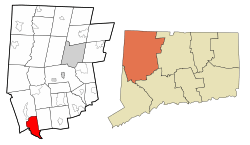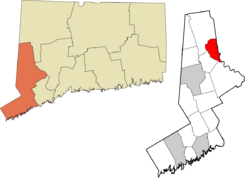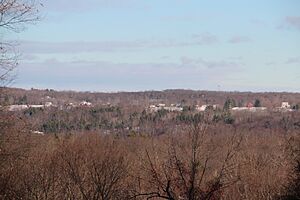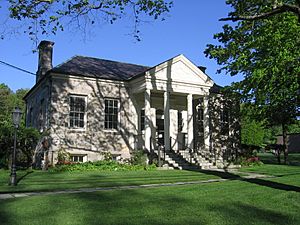Bridgewater, Connecticut facts for kids
Quick facts for kids
Bridgewater, Connecticut
|
||
|---|---|---|

A historic house in the town center
|
||
|
||
 Litchfield County and Connecticut Litchfield County and Connecticut Western Connecticut Planning Region and Connecticut Western Connecticut Planning Region and Connecticut |
||
| Country | United States | |
| U.S. state | Connecticut | |
| County | Litchfield | |
| Region | Western CT | |
| Incorporated | 1856 | |
| Government | ||
| • Type | Selectman-town meeting | |
| Area | ||
| • Total | 17.31 sq mi (44.82 km2) | |
| • Land | 16.39 sq mi (42.46 km2) | |
| • Water | 0.91 sq mi (2.36 km2) | |
| Elevation | 715 ft (218 m) | |
| Population
(2020)
|
||
| • Total | 1,662 | |
| • Density | 96.04/sq mi (37.082/km2) | |
| Time zone | UTC−5 (Eastern) | |
| • Summer (DST) | UTC−4 (Eastern) | |
| ZIP Code |
06752
|
|
| Area code(s) | 860/959 | |
| FIPS code | 09-08210 | |
| GNIS feature ID | 0213397 | |
| Website | bridgewater-ct.gov | |
Bridgewater is a small and charming town located in Litchfield County, Connecticut, United States. In 2020, about 1,662 people lived here. It's known for its beautiful wooded areas and being close to Lake Lillinonah.
Bridgewater is a popular spot for people looking for a peaceful escape, especially from New York City. For a long time, Bridgewater was one of the few towns in Connecticut where alcohol sales were not allowed. However, in 2014, residents voted to allow alcohol sales. Every August, the town hosts the Bridgewater Country Fair, a very popular event that brings in visitors from all over New England.
Contents
Geography and Nature
Bridgewater is in the southwestern part of Litchfield County. It shares borders with Fairfield County to the south and New Haven County to the southeast. The town covers about 44.8 square kilometers (17.3 square miles). Most of this area is land, with a small part being water.
Bridgewater sits on the northeastern side of the Housatonic River. This part of the river forms a lake called Lake Lillinonah. The town is about 13 miles southwest of Danbury and 20 miles east of Waterbury.

Population and People
The number of people living in Bridgewater has changed over the years. In 1850, there were 815 residents. The population grew to 1,824 in 2000, but then slightly decreased to 1,662 by 2020.
| Historical population | |||
|---|---|---|---|
| Census | Pop. | %± | |
| 1850 | 815 | — | |
| 1860 | 1,048 | 28.6% | |
| 1870 | 877 | −16.3% | |
| 1880 | 708 | −19.3% | |
| 1890 | 617 | −12.9% | |
| 1900 | 649 | 5.2% | |
| 1910 | 600 | −7.6% | |
| 1920 | 481 | −19.8% | |
| 1930 | 432 | −10.2% | |
| 1940 | 537 | 24.3% | |
| 1950 | 639 | 19.0% | |
| 1960 | 898 | 40.5% | |
| 1970 | 1,277 | 42.2% | |
| 1980 | 1,563 | 22.4% | |
| 1990 | 1,654 | 5.8% | |
| 2000 | 1,824 | 10.3% | |
| 2010 | 1,727 | −5.3% | |
| 2020 | 1,662 | −3.8% | |
| U.S. Decennial Census | |||
Most households in Bridgewater are families, with many married couples. About 29.4% of households have children under 18 living with them. The average age of residents in Bridgewater is around 45 years old.
Voter Information
In Bridgewater, people can register to vote for different political parties. As of October 2021, here's how voters were registered:
| Voter registration and party enrollment as of October 26, 2021 | |||||
|---|---|---|---|---|---|
| Party | Active voters | Inactive voters | Total voters | Percentage | |
| Democratic | 466 | 3 | 469 | 32.71% | |
| Republican | 417 | 9 | 426 | 29.71% | |
| Unaffiliated | 513 | 7 | 520 | 36.26% | |
| Minor Parties | 19 | 0 | 19 | 1.32% | |
| Total | 1,415 | 19 | 1,434 | 100% | |
Getting Around Town
Bridgewater has two main state highways that help people travel:
- Route 67 runs east-west in the northern part of town. It connects to New Milford to the northwest and Roxbury to the east.
- Route 133 runs north-south. It crosses the Housatonic River into Brookfield.
The Danbury Metro-North Railroad station is about 10 miles from the center of Bridgewater. This train station can connect residents to larger cities.
Local News and Media
Residents of Bridgewater can get their news from several local sources:
- Waterbury Republican-American: A daily newspaper based in Waterbury.
- The News-Times: A daily newspaper from Danbury.
- The Greater New Milford Spectrum: A weekly newspaper.
- Voices: A local newspaper that covers Bridgewater and many surrounding towns.
Education in Bridgewater
Bridgewater is part of Regional School District 12.
- Younger students attend REACH Preschool in Washington and Burnham Elementary School in Bridgewater.
- Older students go to Shepaug Valley School (a secondary school) in Washington.
The Burnham Library
The Bridgewater Library Association started in 1904. In 1909, a space for the library was set up in the town hall. A man named William Dixon Burnham, who grew up in Bridgewater and became wealthy in shipping, left money to the town. This money helped build a beautiful new library building between 1925 and 1926. It was made in the Greek Revival style using granite from a nearby mine. The library officially opened on August 26, 1926.
By the early 1960s, the library needed more space. A fund was started to build an addition named after Van Wyck Brooks, a famous writer who lived in town. Even with support from well-known people like Pearl Buck, not enough money was raised for the wing. However, they did collect enough for a statue of Brooks and a display of some of his belongings, which you can still see in the library.
Then, in 1973, something very unexpected happened. A man named Charles E. Piggott, who lived a very simple and private life in Los Angeles, passed away. When his old home was being cleared, a bottle was found with his will inside. Even though he didn't seem to have any connection to Bridgewater, Piggott left $300,000 to the Van Wyck Brooks Memorial Fund!
The state of California tried to challenge the will, but the library hired a lawyer and eventually won the case, receiving $210,000. This amazing donation allowed the library to build the Van Wyck Brooks Memorial Wing, which doubled its size, and it was dedicated in 1980.
A local writer, Burton Bernstein, later investigated why Piggott would leave money to Bridgewater. He found that Piggott loved public libraries and was a big reader. Bernstein believes Piggott might have read Van Wyck Brooks' book, The Flowering of New England, which talks about the private life of Henry David Thoreau. Piggott might have felt a connection to Thoreau's ideas about living simply. This connection might have inspired him to donate to the library's fund.
Famous People from Bridgewater
Many interesting people have lived in Bridgewater, including:
- Woody Allen: A famous film director, writer, and actor.
- Mia Farrow: A well-known actress.
- Louise Fitzhugh: Author of children's books, like Harriet the Spy.
- Mike Nichols: A celebrated film and theater director.
- Diane Sawyer: A respected television journalist.
- Van Wyck Brooks (1886–1963): A literary critic and historian.
- E.G. Marshall (1914–1998): A popular actor.
- Teresa Wright (1918–2005): An Academy Award-winning actress.
See also
 In Spanish: Bridgewater (Connecticut) para niños
In Spanish: Bridgewater (Connecticut) para niños




